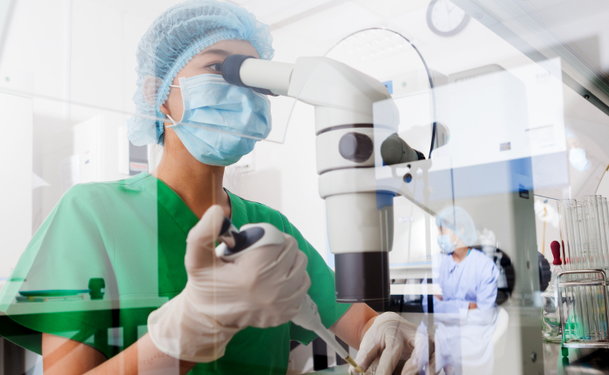ZIFT is understood to be the most invasive of all the assisted reproductive technologies (ART), and it accounts for less than 1 percent of all ART procedures.
Still, if you have healthy, undamaged fallopian tubes, haven't been able to conceive using traditional IVF, and if male fertility issues are a significant factor (low sperm count, motility, etc), your doctor may recommend zygote intrafallopian transfer (ZIFT).
IVF, GIFT and ZIFT: What are the differences
ZIFT is similar to in vitro fertilization (IVF) and gamete intrafallopian transfer (GIFT). In all of these procedures, your doctor removes your eggs from your ovaries and mixes them with your partner's sperm in a laboratory dish, before returning them to your body. There are differences however.
- In an IVF procedure (by far the most common ART technique), the sperm fertilizes the egg in a laboratory dish and then develops into an embryo in the lab. On day three to five, your doctor then transfers the embryos directly to your uterus through a non-invasive procedure.
- In a GIFT procedure, your doctor uses laparoscopy (a surgical procedure) to place your unfertilized eggs and your partner's sperm directly in to your fallopian tube. From here, the process mimics a natural pregnancy. The sperm fertilizes the egg in your fallopian tube, and then the fertilized egg travels down the fallopian tube to the uterus where it implants.
- In a ZIFT procedure, the sperm fertilizes the egg in a laboratory dish, and then the next day, your doctor transfers the zygotes (fertilized egg cells) into your fallopian tubes via laparoscopic surgery.
From this point on, the process mimics a natural pregnancy: The zygote develops into an embryo as it travels down the fallopian tube and then implants into the uterus.
The ZIFT procedure
The ZIFT procedure includes ovarian stimulation and monitoring, egg retrieval and sperm collection, IVF, and then implantation via laparoscopy. Total time for the procedure is four to eight weeks.
Ovarian stimulation and monitoring
As is the case with all ART procedures, you will take hormones that stimulate your ovaries into producing multiple eggs, and your ovarian follicles into growing and getting ready to release the eggs. Your doctor will closely monitor your estrogen and progesterone levels with blood testing, and the health of your ovaries and ovarian follicle growth with ultrasound. Generally, this will go on for eight to 14 days.
Ovulation induction, egg retrieval and sperm collection
When the follicles are ready, your doctor will administer hCG or other medications to stimulate growth of the eggs and speed up their "maturation" so that they are ready for fertilization, and you are ready to ovulate them into your fallopian tubes.
Egg retrieval. Usually 34 to 36 hours after giving the hCG injection, your doctor will retrieve the eggs from your ovaries. Egg retrieval usually takes about 30 minutes, and since it can be slightly uncomfortable, your doctor may give you pain medication.
Sperm collection. During, or prior to this point, sperm is collected, either through masturbation or directly from the testicles, and prepared by being "washed" of semen and examined for any health issues.
Hormone injections. At home, you will take hormone injections to increase your progesterone levels--this will cause the lining of the ovaries, fallopian tubes and uterus to thicken, which improves the chances of your zygote safely implanting in the uterine lining and growing. You may need to take this for up to eight weeks, depending on your personal fertility treatment plan.
In-vitro fertilization (IVF)
Unless there are issues with sperm health, IVF involves placing eggs and sperm together in a nutrient-rich glass dish/tray for the fertilization period of 12 to 24 hours. If there are sperm issues that may prevent them from penetrating and fertilizing the egg, then a single sperm may be directly injected into each egg—a process called intracytoplasmic sperm injection (ICSI).
Implantation of the zygote via laparoscopy
A zygote is the single cell produced when a woman's egg and a male's sperm join—there is then a roughly two-week period in which the zygote rapidly divides (a process known as mitosis), eventually becoming an embryo.
The day after your egg retrieval, your doctor will inject the zygotes directly into your fallopian tubes using a surgical technique called laparoscopy. You will typically need general anesthesia for this procedure.
In this step you doctor will:
- Make two small incisions in the abdomen and above the pubic bone.
- Insert a video camera (a laparoscope) into one of the incisions.
- Insert the needle and catheter containing your zygotes to the fallopian tubes, using the laparascope for guidance.
- Inject the zygotes directly into your fallopian tubes (once the needle is in the correct location).
- Stitch up the incisions, thus completing the ZIFT cycle.
Following the ZIFT cycle, you will continue to take fertility enhancing progesterone treatments while you wait on a "natural" timetable for a pregnancy. Within two weeks, you will take a blood test to find out if you are pregnant.
Updated August 2014


